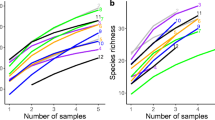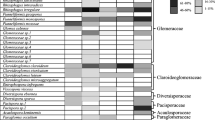Abstract
Although it has become increasingly clear that arbuscular mycorrhizal fungi (AMF) play important roles in population, community, and ecosystem ecology, there is limited information on the spatial structure of the community composition of AMF in the field. We assessed small-scale spatial variation in the abundance and molecular diversity of AMF in a calcareous fen, where strong underlying environmental gradients such as depth to water table may influence AMF. Throughout an intensively sampled 2 × 2 m plot, we assessed AMF inoculum potential at a depth of 0–6 and 6–12 cm and molecular diversity of the AMF community using terminal restriction fragment length polymorphism of 18S rDNA. Inoculum potential was only significantly spatially autocorrelated at a depth of 6–12 cm and was significantly positively correlated with depth to water table at both depths. Molecular diversity of the AMF community was highly variable within the plot, ranging from 2–14 terminal restriction fragments (T-RFs) per core, but the number of T-RFs did not relate to water table or plant species richness. Plant community composition was spatially autocorrelated at small scales, but AMF community composition showed no significant spatial autocorrelation. Saturated soils of calcareous fens contain many infective AMF propagules and the abundance and diversity of AMF inoculum is patchy over small spatial scales.





Similar content being viewed by others
References
Bedford BL, Godwin KS (2003) Fens of the United States: distribution, characteristics, and scientific connection versus legal isolation. Wetlands 23:608–629
Boerner REJ, DeMars BG, Leicht PN (1996) Spatial patterns of mycorrhizal infectiveness of soils along a successional chronosequence. Mycorrhiza 6:79–90
Brundrett MC, Abbott LK (1995) Mycorrhizal fungus propagules in the jarrah forest. 2. Spatial variability in inoculum levels. New Phytol 131:461–469
Brundrett MC, Piche Y, Peterson RL (1984) A new method for observing the morphology of vesicular–arbuscular mycorrhizae. Can J Bot 62:2128–2134
Burrows RL, Pfleger FL (2002) Arbuscular mycorrhizal fungi respond to increasing plant diversity. Can J Bot 80:120–130
Cantelmo AJ, Ehrenfeld JG (1999) Effects of microtopography on mycorrhizal infection in Atlantic white cedar (Chamaecyparis thyoides (L.) Mills.). Mycorrhiza 8:175–180
Carvalho LM, Cacador I, Martins-Loucao MA (2001) Temporal and spatial variation of arbuscular mycorrhizas in salt marsh plants of the Tagus estuary (Portugal). Mycorrhiza 11:303–309
Carvalho LM, Correia PM, Ryel RJ, Martins-Loucao MA (2003) Spatial variability of arbuscular mycorrhizal fungal spores in two natural plant communities. Plant Soil 251:227–236
Carvalho LM, Correia PM, Martins-Loucao MA (2004) Arbuscular mycorrhizal fungal propagules in a salt marsh. Mycorrhiza 14:165–170
Clapp JP, Helgason T, Daniell TJ, Young JPW (2002) Genetic studies of the structure and diversity of arbuscular mycorrhizal fungal communities. In: van der Heijden MGA, Sanders IR (eds) Mycorrhizal ecology. Springer, Berlin Heidelberg New York, pp 201–221
Clifford P, Richardson S, Hemon D (1989) Assessing the significance of the correlation between two spatial processes. Biometrics 45:123–134
Colmer TD (2003) Long-distance transport of gases in plants: a perspective on internal aeration and radial oxygen loss from roots. Plant Cell Environ 26:17–36
Cornwell WK, Bedford BL, Chapin CT (2001) Occurrence of arbuscular mycorrhizal fungi in a phosphorus-poor wetland and mycorrhizal response to phosphorus fertilization. Am J Bot 88:1824–1829
Douhan GW, Peterson C, Bledsoe C, Rizzo DM (2005) Contrasting root associated fungi of three common oak-woodland plant species based on molecular identification: host specificity or non-specific amplification? Mycorrhiza 15:365–372
Dunbar J, Ticknor LO, Kuske CR (2001) Phylogenetic specificity and reproducibility and new method for analysis of terminal restriction fragment profiles of 16S rRNA genes from bacterial communities. Appl Environ Microbiol 67:190–197
Dunham RM, Ray AM, Inouye RS (2003) Growth, physiology, and chemistry of mycorrhizal and nonmycorrhizal Typha latifolia seedlings. Wetlands 23:890–896
Ettema CH, Wardle DA (2002) Spatial soil ecology. Trends Ecol Evol 17:177–183
Fortin MJ, Dale MRT (2005) Spatial analysis: a guide for ecologists. Cambridge University Press, New York
Gange AC, Brown VK, Aplin DM (2005) Ecological specificity of arbuscular mycorrhizae: evidence from foliar- and seed-feeding insects. Ecology 86:603–611
Godwin KS, Shallenberger JP, Leopold DJ, Bedford BL (2002) Linking landscape properties to local hydrogeologic gradients and plant species occurrence in minerotrophic fens of New York State, USA: a hydrogeologic setting (HGS) framework. Wetlands 22:722–737
Hart M, Klironomos JN (2002) Diversity of arbuscular mycorrhizal fungi and ecosystem functioning. In: van der Heijden MGA, Sanders IR (eds) Mycorrhizal ecology. Springer, Berlin Heidelberg New York, pp 225–239
Helgason T, Fitter AH, Young JPW (1999) Molecular diversity of arbuscular mycorrhizal fungi colonising Hyacinthoides non-scripta (bluebell) in a seminatural woodland. Mol Ecol 8:659–666
Horner-Devine MC, Lage M, Hughes JB, Bohannan BJM (2004) A taxa–area relationship for bacteria. Nature 432:750–753
Johnson NC, O’Dell T, Bledsoe C (1999) Methods for ecological studies of mycorrhizae. In: Robertson GP, Bledsoe C, Coleman DC, Sollins P (eds) Standard soil methods for long-term ecological research. Oxford University Press, New York, pp 378–412
Johnson D, Vandenkoornhuyse PJ, Leake JR, Gilbert L, Booth RE, Grime JP, Young JPW, Read DJ (2004) Plant communities affect arbuscular mycorrhizal fungal diversity and community composition in grassland microcosms. New Phytol 161:503–515
Keddy P (2000) Wetland ecology: principles and conservation. Cambridge University Press, New York
Koide RT, Dickie IA (2002) Effects of mycorrhizal fungi on plant populations. Plant Soil 244:307–317
McGonigle TP, Miller MH, Evans DG, Fairchild GL, Swan JA (1990) A new method which gives an objective measure of colonization of roots by vesicular–arbuscular mycorrhizal fungi. New Phytol 115:495–501
Miller SP (2000) Arbuscular mycorrhizal colonization of semi-aquatic grasses along a wide hydrologic gradient. New Phytol 145:145–155
Miller SP, Bever JD (1999) Distribution of arbuscular mycorrhizal fungi in stands of the wetland grass Panicum hemitomon along a wide hydrologic gradient. Oecologia 119:586–592
Miller SP, Sharitz RR (2000) Manipulation of flooding and arbuscular mycorrhiza formation influences growth and nutrition of two semiaquatic grass species. Funct Ecol 14:738–748
Mitsch WJ, Gosselink JG (2000) Wetlands. Wiley, New York
Mummey DL, Rillig MC, Holben WE (2005) Neighboring plant influences on AMF community composition: a potential mechanism for invasive plant success. Plant Soil 271:83–90
Opik M, Moora M, Liira J, Koljalg U, Zobel M, Sen R (2003) Divergent arbuscular mycorrhizal fungal communities colonize roots of Pulsatilla spp. in boreal Scots pine forest and grassland soils. New Phytol 160:581–593
Pringle A, Bever JD (2002) Divergent phenologies may facilitate the coexistence of arbuscular mycorrhizal fungi in a North Carolina grassland. Am J Bot 89:1439–1446
Rickerl DH, Sancho FO, Ananth S (1994) Vesicular–arbuscular endomycorrhizal colonization of wetland plants. J Environ Qual 23:913–916
Ritz K, McNicol W, Nunan N, Grayston S, Millard P, Atkinson D, Gollotte A, Habeshaw D, Boag B, Clegg CD, Griffiths BS, Wheatley RE, Glover LA, McCaig AE, Prosser JI (2004) Spatial structure in soil chemical and microbiological properties in an upland grassland. FEMS Microbiol Ecol 49:191–205
Rosendahl S, Stukenbrock EH (2004) Community structure of arbuscular mycorrhizal fungi in undisturbed vegetation revealed by analyses of LSU rDNA sequences. Mol Ecol 13:3179–3186
Stevens KJ, Peterson RL (1996) The effect of a water gradient on the vesicular–arbuscular mycorrhizal status of Lythrum salicaria L (purple loosestrife). Mycorrhiza 6:99–104
Stevens KJ, Spender SW, Peterson RL (2002) Phosphorus, arbuscular mycorrhizal fungi and performance of the wetland plant Lythrum salicaria L. under inundated conditions. Mycorrhiza 12:277–283
Turner SD, Amon JP, Schneble RM, Friese CF (2000) Mycorrhizal fungi associated with plants in ground-water fed wetlands. Wetlands 20:200–204
USDA NRCS (2004) The PLANTS Database, Version 3.5 (http://plants.usda.gov). National Plant Data Center, Baton Rouge, LA 70874–4490 USA
van der Heijden MGA, Sanders IR (eds) (2002) Mycorrhizal ecology. Springer, Berlin Heidelberg New York
van der Heijden MGA, Klironomos JN, Ursic M, Moutoglis P, Streitwolf-Engel R, Boller T, Wiemken A, Sanders IR (1998) Mycorrhizal fungal diversity determines plant biodiversity, ecosystem variability and productivity. Nature 396:69–72
Vandenkoornhuyse P, Ridgway KP, Watson IJ, Fitter AH, Young JPW (2003) Co-existing grass species have distinctive arbuscular mycorrhizal communities. Mol Ecol 12:3085–3095
Weishampel PA (2005) Distribution and function of arbuscular mycorrhizal fungi in calcareous fen plant communities. PhD Dissertation. Cornell University, Ithaca, NY
Wirsel SGR (2004) Homogenous stands of a wetland grass harbour diverse consortia of arbuscular mycorrhizal fungi. FEMS Microbiol Ecol 48:129–138
Wolfe BE, Weishampel PA, Klironomos JN (2006) Arbuscular mycorrhizal fungi and water table affect wetland plant community. J of Eco 94:905–914
Acknowledgements
Hafiz Maherali, Doug Larson, and Peter Weishampel provided useful comments on earlier versions of this manuscript. This work was funded by the US National Science Foundation and the Natural Sciences and Engineering Research Council of Canada.
Author information
Authors and Affiliations
Corresponding author
Rights and permissions
About this article
Cite this article
Wolfe, B.E., Mummey, D.L., Rillig, M.C. et al. Small-scale spatial heterogeneity of arbuscular mycorrhizal fungal abundance and community composition in a wetland plant community. Mycorrhiza 17, 175–183 (2007). https://doi.org/10.1007/s00572-006-0089-y
Received:
Accepted:
Published:
Issue Date:
DOI: https://doi.org/10.1007/s00572-006-0089-y




